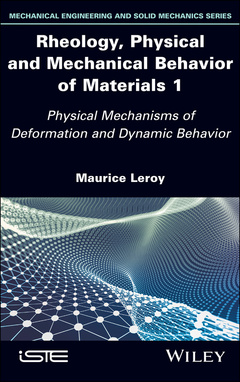Description
Rheology, Physical and Mechanical Behavior of Materials 1
Physical Mechanisms of Deformation and Dynamic Behavior
Author: Leroy Maurice
Language: English
Subjects for Rheology, Physical and Mechanical Behavior of Materials 1:
· Hardback
Description
/li>Contents
/li>Biography
/li>
Rheology, Physical and Mechanical Behavior of Materials 1 presents analyses of plasticity mechanisms at microscopic and macroscopic scales, and of the various forms of stressstrain behavior laws according to working speeds, mechanisms, athermics, viscoplasticity and formability limits at types and speeds of change.
It is aimed at researchers involved in the mechanics of deformable media, as well as industrial design and manufacturing departments
Preface xi
Chapter 1 Dynamic Plasticity: Dislocations 1
1.1 Introduction: how to describe plasticity? 1
1.2 Strain speed: ε (γ for shearing) 7
1.3 The microstructural mechanisms of plasticity 16
Chapter 2 Obstacles and Mechanisms of Crossings 59
2.1 Obstacles 60
2.2 Nature and resistance of obstacles 61
2.3 Example of measuring dislocation speeds 62
2.4 Microstructural mechanisms of the deformation rate 67
2.5 Mechanisms due to obstacles: hardening mechanisms 68
2.6 Athermal mechanism of the movement of a dislocation 116
2.7 Thermally activated mechanism of the movement of a dislocation 122
2.8 The viscous friction mechanism 129
Chapter 3 Dynamic Flows for Monocrystals and Polycrystals 137
3.1 Type of monocristal and polycrystal dynamic shear test samples (anisotropy and isotropy at high speeds) 138
3.2 The tensor of the shock stresses 139
3.3 Study of strain on a polycrystal 140
3.4 Dynamic flows by electromagnetic shocks, polycrystalline aluminum A5 140
3.5 The case of six polycrystals 142
3.6 The case of monocrystals 143
3.7 Models for CFCs 147
3.8 Dynamics of flows shown using an ultra-fast camera 152
3.9 Viscoplasticity 161
3.10 References for viscoplasticity 170
Chapter 4 Limits to Static and Dynamic Formability 173
4.1 Plastic instability 173
4.2 Forming by pressing 181
4.3 Damage: area between necking and fracture, the case between Forming Limit Curves (FLCs) and Fracture Forming Limit Curves (FFLCs) 190
4.4 Limit of the formability during necking (FLCs) and during fracture (FFLCs): influence of the strain rate 196
Chapter 5 Dynamic Resistance to Mechanical Shocks 219
5.1 Shock stresses 219
5.2 Resilience test 227
5.3 Typical loads, stress waves 251
5.4 Dynamic tests, Hopkinson technique, laws of behavior 264
Appendix A Primary Times of Mechanisms 289
References 313
Index 319
Maurice Leroy is a lecturer and professor at the University of Nantes, France, as well as director of the Composite and Metallic Formations research laboratory at the IUT. He was instrumental in the creation of France’s first Materials Science and Engineering department.
These books may interest you

Nonlinear Dynamics of Structures 52.74 €

Nonlinear Dynamics of Structures 52.74 €


